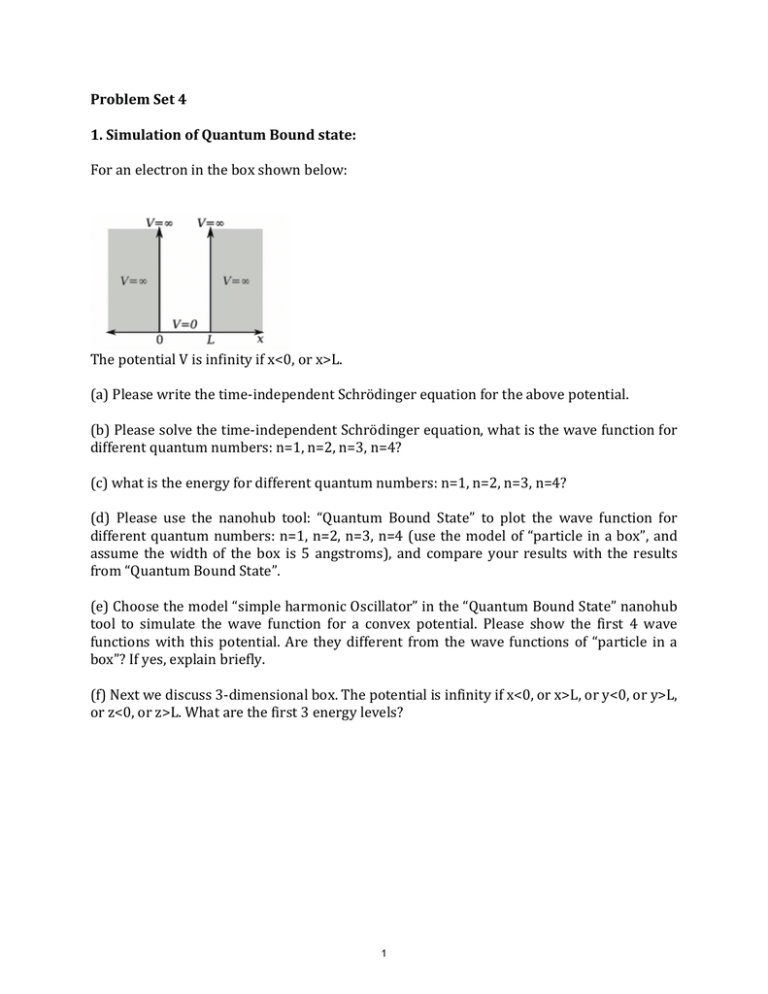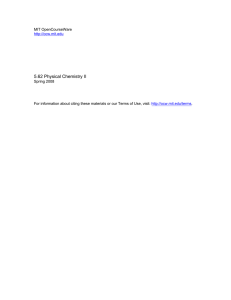Document 13551627
advertisement

Problem Set 4 1. Simulation of Quantum Bound state: For an electron in the box shown below: The potential V is infinity if x<O, or x>L. (a) Please write the time-independent Schrodinger equation for the above potential. (b) Please solve the time-independent Schrodinger equation, what is the wave function for different quantum numbers: n=l, n=2, n=3, n=4? (c) what is the energy for different quantum numbers: n=l, n=2, n=3, n=4? (d) Please use the nanohub tool: "Quantum Bound State" to plot the wave function for different quantum numbers: n=l, n=2, n=3, n=4 (use the model of "particle in a box", and assume the width of the box is 5 angstroms), and compare your results with the results from "Quantum Bound State". (e) Choose the model "simple harmonic Oscillator" in the "Quantum Bound State" nanohub tool to simulate the wave function for a convex potential. Please show the first 4 wave functions with this potential. Are they different from the wave functions of "particle in a box"? If yes, explain briefly. (f) Next we discuss 3-dimensional box. The potential is infinity if x<O, or x>L, or y<O, or y>L, or z<O, or z>L. What are the first 3 energy levels? 1 2. Simulation of a N2 molecule using nanoHUB: In this problem we will study the molecular binding in a N2 molecule using the nanoHUB tool: "MIT Atomic Scale Modeling Toolkit". Once the tool is running, select the "Quantum Chemistry (GAMESS)" tool from the top right corner pull-down menu. Please select method as "DFT-LDA". Use the default settings for all other parameters to begin with. This means that the run type is "energy", basis set is "3-2lG", etc. In the coordinate window in the lower left enter coordinates for the N2 molecule. Do this by selecting "New" and entering the coordinates in xyz format. (a) Compute the total energy for different values of the separation between the two N atoms. Show how the total energy changes as a function of separation d. (b) Find the molecular binding distance dbind by finding a minimum in the total energy. (c) Plot the total energy as a function of d over a reasonable range dmin : d : dmax which includes dbind. (d) Find the stretching frequency of N2 by calculating the second derivative of the energy with respect to the interatomic distance, calculated around equilibrium. (e) Now change either the basis set (i.e., 6-3lG) or the method (i.e., BLYP) and find the stretch frequency again. Is it different? If so, explain briefly. (f) What is the advantage of a DFT calculation compared to a classical potential (e.g. LJ potential)? 2 MIT OpenCourseWare http://ocw.mit.edu 3.021J / 1.021J / 10.333J / 18.361J / 22.00J Introduction to Modeling and Simulation Spring 2012 For information about citing these materials or our Terms of Use, visit: http://ocw.mit.edu/terms.







